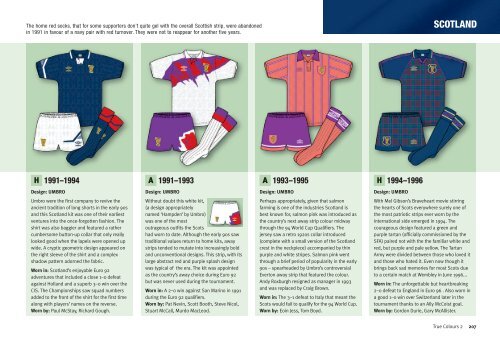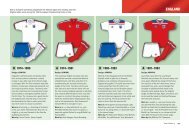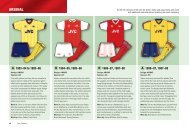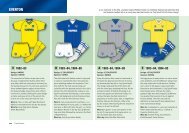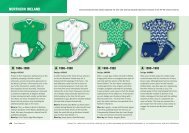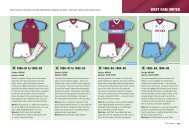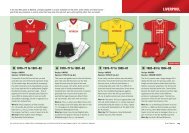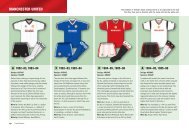Scotland - True Colours Football Kits
Scotland - True Colours Football Kits
Scotland - True Colours Football Kits
Create successful ePaper yourself
Turn your PDF publications into a flip-book with our unique Google optimized e-Paper software.
The home red socks, that for some supporters don’t quite gel with the overall Scottish strip, were abandoned<br />
in 1991 in favour of a navy pair with red turnover. They were not to reappear for another five years.<br />
SCOTLAND<br />
H<br />
1991–1994<br />
A<br />
1991–1993<br />
A<br />
1993–1995<br />
H<br />
1994–1996<br />
Design: UMBRO<br />
Umbro were the first company to revive the<br />
ancient tradition of long shorts in the early 90s<br />
and this <strong>Scotland</strong> kit was one of their earliest<br />
ventures into the once-forgotten fashion. The<br />
shirt was also baggier and featured a rather<br />
cumbersome button-up collar that only really<br />
looked good when the lapels were opened up<br />
wide. A cryptic geometric design appeared on<br />
the right sleeve of the shirt and a complex<br />
shadow pattern adorned the fabric.<br />
Worn in: <strong>Scotland</strong>’s enjoyable Euro 92<br />
adventures that included a close 1–0 defeat<br />
against Holland and a superb 3–0 win over the<br />
CIS. The Championships saw squad numbers<br />
added to the front of the shirt for the first time<br />
along with players’ names on the reverse.<br />
Worn by: Paul McStay, Richard Gough.<br />
Design: UMBRO<br />
Without doubt this white kit,<br />
(a design appropriately<br />
named ‘Hampden’ by Umbro)<br />
was one of the most<br />
outrageous outfits the Scots<br />
had worn to date. Although the early 90s saw<br />
traditional values return to home kits, away<br />
strips tended to mutate into increasingly bold<br />
and unconventional designs. This strip, with its<br />
large abstract red and purple splash design<br />
was typical of the era. The kit was appointed<br />
as the country’s away choice during Euro 92<br />
but was never used during the tournament.<br />
Worn in: A 2–0 win against San Marino in 1991<br />
during the Euro 92 qualifiers.<br />
Worn by: Pat Nevin, Scott Booth, Steve Nicol,<br />
Stuart McCall, Murdo MacLeod.<br />
Design: UMBRO<br />
Perhaps appropriately, given that salmon<br />
farming is one of the industries <strong>Scotland</strong> is<br />
best known for, salmon pink was introduced as<br />
the country’s next away strip colour midway<br />
through the 94 World Cup Qualifiers. The<br />
jersey saw a retro 1920s collar introduced<br />
(complete with a small version of the <strong>Scotland</strong><br />
crest in the neckpiece) accompanied by thin<br />
purple and white stripes. Salmon pink went<br />
through a brief period of popularity in the early<br />
90s – spearheaded by Umbro’s controversial<br />
Everton away strip that featured the colour.<br />
Andy Roxburgh resigned as manager in 1993<br />
and was replaced by Craig Brown.<br />
Worn in: The 3–1 defeat to Italy that meant the<br />
Scots would fail to qualify for the 94 World Cup.<br />
Worn by: Eoin Jess, Tom Boyd.<br />
Design: UMBRO<br />
With Mel Gibson’s Braveheart movie stirring<br />
the hearts of Scots everywhere surely one of<br />
the most patriotic strips ever worn by the<br />
international side emerged in 1994. The<br />
courageous design featured a green and<br />
purple tartan (officially commissioned by the<br />
SFA) paired not with the the familiar white and<br />
red, but purple and pale yellow. The Tartan<br />
Army were divided between those who loved it<br />
and those who hated it. Even now though it<br />
brings back sad memories for most Scots due<br />
to a certain match at Wembley in June 1996...<br />
Worn in: The unforgettable but heartbreaking<br />
2–0 defeat to England in Euro 96 . Also worn in<br />
a good 1–0 win over Switzerland later in the<br />
tournament thanks to an Ally McCoist goal.<br />
Worn by: Gordon Durie, Gary McAllister.<br />
<strong>True</strong> <strong>Colours</strong> 2 207
SCOTLAND<br />
Strangely, the white 03–05 away shirt was worn at home when <strong>Scotland</strong> faced Trinidad and Tobago in a 2004 friendly.<br />
A 2002–2003<br />
H<br />
2003–2005<br />
A<br />
2003–2005<br />
3<br />
2004–2006<br />
Design: FILA<br />
Lemon yellow returned to Hampden in this<br />
minimally elegant away strip that was<br />
launched a short while after the pinstriped<br />
home shirt. The smart-looking jersey featured<br />
a streamlined crew-neck and, like the last<br />
Umbro change strip, included a simple navy<br />
chest band that housed the Fila logo and<br />
<strong>Scotland</strong> crest. The shorts and socks simply<br />
mirrored the design of the home pairs. Both<br />
this and the first choice navy kit were used for<br />
one year, with 2003 marking the end of the<br />
SFA’s three-year contract with Fila.<br />
Worn in: A 2–0 win over Iceland in the Euro<br />
2004 qualifying campaign with goals from<br />
Naysmith and Dailly.<br />
Worn by: Kevin Kyle, Steven Thompson,<br />
Maurice Ross, Scott Dobie, Paul Devlin.<br />
Design: DIADORA<br />
It was all change on the <strong>Scotland</strong> kit front in<br />
2003. Not only was there a new home and<br />
away strip from new kit supplier Diadora, but a<br />
redesigned version of the Scottish crest was<br />
also launched. It incorporated the St Andrews<br />
cross and ‘<strong>Scotland</strong>’ text above the familiar<br />
shield. Diadora’s first home kit was a<br />
competent enough affair. It featured a<br />
contemporary double-layered neck design with<br />
white fabric inserts running from the neck to<br />
under each arm. The socks reverted to a<br />
maroon-topped navy.<br />
Worn in: The magnificent 1–0 win over the<br />
Netherlands in the Euro 2004 play off 1st leg<br />
(2003). Also worn in the 1–1 draw with Moldova<br />
that led to Vogts’ departure the following year.<br />
Worn by: Paul Dickov, James McFadden.<br />
Design: DIADORA<br />
Diadora kept it simple with their first <strong>Scotland</strong><br />
away strip. Formed from a workmanlike white<br />
and navy, sophistication was added with the<br />
inclusion of reversed seams that curved<br />
anatomically down the front of the jersey along<br />
with tapered navy shoulder flashes. The curved<br />
seams continued in white on the shorts that<br />
were also worn with the home kit on occasion.<br />
Bertie Vogts left the <strong>Scotland</strong> post in<br />
November 2004 and was eventually replaced<br />
by ex-Rangers manager Walter Smith.<br />
Worn in: The not so wonderful 6–0 thrashing at<br />
the hands of the Netherlands in the 2nd leg of<br />
the Euro 2004 play offs that denied the<br />
hopeful Scots of a place in the finals.<br />
Worn by: Barry Ferguson, Steven Pressley,<br />
Darren Fletcher, Neil McCann, Gavin Rae.<br />
Design: DIADORA<br />
This fine looking amber jersey was the first<br />
official third shirt worn by a Scottish side.<br />
Consisting of a standard Diadora template of<br />
the time, the lightweight shirt featured a<br />
asymmetrical neck, angled navy mesh inset<br />
strips that aided moisture control and<br />
Diadora’s hi-tech ‘one of eleven’ shoulder<br />
flashes that changed colour depending on<br />
body temperature. The plumper members of<br />
the Tartan Army, keen for their own replica<br />
versions, were possibly a little nervous on<br />
seeing how figure-hugging the jersey was.<br />
Fortunately XXL replicas were produced.<br />
Worn in: A 3–0 home defeat to Hungary in a<br />
2004 friendly – it was the kit’s debut and the<br />
biggest Scots defeat at Hampden since 1973.<br />
Worn by: Richard Hughes, Andy Webster.<br />
210 <strong>True</strong> <strong>Colours</strong> 2


